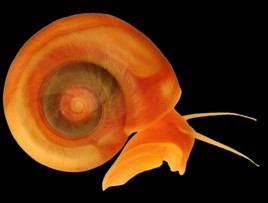|
FRESHWATER SNAILSCeratophallus natalensisESCARGOT FOR FISH
As I was writing this piece, I was wondering how a fly fisherman would imitate this creature on a hook. Then I started wondering about how popular freshwater snails really were in relation to fly fishing. The answer is a mixture of science and nature mixed with a little wonder on my part. Most freshwater types we see are the terrestrial ones, the ones that live primarily on land. You may be astonished to find that they come in several varieties. There are those that are hermaphroditic (asexual) while other varieties have male and female counterparts. Some have gills and others have lungs.
Most lay eggs in sacs, but there are a few that actually birth live like mammals. A male can be identified by a slightly longer, curved right antenna. The females have two identical antennae. All in all, I find these creatures to be very interesting. Oh, I still find them slimy and yucky, but they do have a job to do in nature that is important as they eat algae and other organic debris from rocks and leaves that would normally dirty up a body of water. This is why they are sought after as aquarium pets. Worldwide, they can be found in about 20 families of the gilled varieties (prosobranchia) and 7 families of lunged varieties (pulmonata). Northeastern America is home to both prosobranchia and pulmonata snails and they are a food source for fish, water birds and leeches. Surprisingly, the crawfish is also a natural enemy of the snail. The basic life span is about three to five years. That is an average among all types, so it differs. Our buddy - a mollusk by the way - will spend that entire time in the place where it is born or hatched. So they can be called "home bodies" if you will.
For this reason, when other food supplies are scarce, the freshwater snail fills the gap for predators very nicely. They are known to be a great source of protein and in waters where they are plentiful; the resident fish can be lunkers! These small protein laden treats tend to be killed off fairly quickly, but most varieties of the asexual snail reproduce several times a month. An average egg cluster is comprised of 100 to 200 eggs of which 50 to 75 will hatch successfully. Do the math and you will see that one asexual escargot can produce about 300 babies a month.
Since they can also get quickly out of hand, it is a good thing that they have numerous natural predators. Imagine a lake teeming with creepy-crawlies! YECCH! All of this put together makes our freshwater friends a fairly productive fly to present in native habitats. Trout will take then right off the top, the bottom or even as the the little guy goes up or down the water column. The best way to fish them is to go to deeper water and let the fly float slowly down. Snap the rod a bit and retrieve. This imitates Ceratophallus natalensis trying to descend to the bottom while appearing to want to stay on top. Fish seem to love this approach! Whatever you do, learn about this mollusk and add it to your fly fishing tackle box.
For further information about fly fishing, please CONTACT US or visit out
Retrun from Snails to Fly Fishing Flies
|









